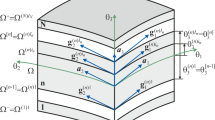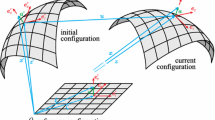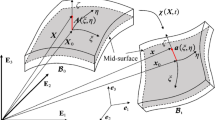Abstract
In this article, a pseudo-stress for local residual and an algebraically derived consistent tangent are applied to elastic–plastic boundary value problems of shells. The authors define a coupled problem of the weak form of the equilibrium equation for the overall structure and the constrained equations for stress state, which include the yield condition and the plane stress condition, at every material point. Since the pseudo-stress for the residuals of yield criterion and plane stress state is incorporated into the linearized weak form of the equilibrium equation, the proposed scheme does not have any local iterative calculations and enables us to decrease the residuals in the coupled boundary value problems simultaneously. Some numerical examples using shell elements demonstrate the validity and effectiveness of the procedures in complex situation with material and geometrical nonlinearities.





















Similar content being viewed by others
References
Bathe K (1996) Finite element procedures in engineering analysis. Prentice Hall Inc, New Jersey
Klinkel S, Govindjee S (2002) Using finite strain 3d-material models in beam and shell elements. Eng Comput (Swansea, Wales) 19(7–8):902–921
Whirley R, Hallquist J, Goudreau G (1989) An assessment of numerical algorithms for plane stress and shell elastoplasticity on supercomputers. Eng Comput 6(2):116–126
Simo J, Taylor R (1985) Consistent tangent operators for rate-independent elastoplasticity. Comput Methods Appl Mech Eng 48(1):101–118
Hartmann S, Quint KJ, Arnold M (2008) On plastic incompressibility within time-adaptive finite elements combined with projection techniques. Comput Methods Appl Mech Eng 198(2):178–193
Nakshatrala P, Tortorelli D (2015) Topology optimization for effective energy propagation in rate-independent elastoplastic material systems. Comput Methods Appl Mech Eng 295:305–326
Owen D, Hinton E (1980) Finite elements in plasticity: theory and practice. Pineridge Press, Pineridge
de Souza Neto E, Peric D, Owen D (2008) Computational methods for plasticity: theory and applications. Wiley, Amsterdam
Nguyen K, Sanz MA, Montans FJ (2020) Plane-stress constrained multiplicative hyperelasto-plasticity with nonlinear kinematic hardening. Consistent theory based on elastic corrector rates and algorithmic implementation. Int J Plast 128:102592
de Borst R (1991) The zero-normal-stress condition in plane-stress and shell elastoplasticity. Commun Appl Numer Methods 7(1):29–33
Ellsiepen P, Hartmann S (2001) Remarks on the interpretation of current non-linear finite element analyses as differential-algebraic equations. Int J Numer Meth Eng 51(6):679–707
Hartmann S (2005) A remark on the application of the Newton-Raphson method in non-linear finite element analysis. Comput Mech 36(2):100–116
Kulkarni DV, Tortorelli DA, Wallin M (2007) A Newton-Schur alternative to the consistent tangent approach in computational plasticity. Comput Methods Appl Mech Eng 196(7):1169–1177
Roehl D, Ramm E (1996) Large elasto-plastic finite element analysis of solids and shells with the enhanced assumed strain concept. Int J Solids Struct 33(20–22):3215–3237
Yamamoto T, Yamada T, Matsui K (2021) Simultaneously iterative procedure based on block newton method for elastoplastic problems. Int J Numer Meth Eng 122(9):2145–2178
Braudel H, Abouaf M, Chenot J (1986) An implicit and incremental formulation for the solution of elastoplastic problems by the finite element method. Comput Struct 22(5):801–814
Braudel H, Abouaf M, Chenot J (1986) An implicit incrementally objective formulation for the solution of elastoplastic problems at finite strain by the FEM. Comput Struct 24(6):825–843
Yamamoto T, Yamada T, Matsui K (2023) Introduction of pseudo-stress for local residual and algebraic derivation of consistent tangent in elastoplasticity. Comput Mech 71(6):1081–1091
Simo J (1998) Numerical analysis and simulation of plasticity. Numerical methods for solids (Part 3) numerical methods for fluids (Part 1), handbook of numerical analysis, vol 6. Elsevier, Heidelberg, pp 183–499
Simo J, Hughes T (1998) Computational inelasticity. Springer, New York
Simo J (1988) A framework for finite strain elastoplasticity based on maximum plastic dissipation and the multiplicative decomposition: Part i continuum formulation. Comput Methods Appl Mech Eng 66(2):199–219
Simo J (1988) A framework for finite strain elastoplasticity based on maximum plastic dissipation and the multiplicative decomposition part ii: Computational aspects. Comput Methods Appl Mech Eng 68(1):1–31
Voce E (1955) A practical strain hardening function. Metallurgia 51:219–226
Eberlein R, Wriggers P (1999) Finite element concepts for finite elastoplastic strains and isotropic stress response in shells: theoretical and computational analysis. Comput Methods Appl Mech Eng 171(3):243–279
Rempler HU, Wieners C, Ehlers W (2011) Efficiency comparison of an augmented finite element formulation with standard return mapping algorithms for elastic-inelastic materials. Comput Mech 48(5):551–562
Simo J, Kennedy J (1992) On a stress resultant geometrically exact shell model part v nonlinear plasticity: formulation and integration algorithms. Comput Methods Appl Mech Eng 96(2):133–171
Betsch P, Stein E (1999) Numerical implementation of multiplicative elasto-plasticity into assumed strain elements with application to shells at large strains. Comput Methods Appl Mech Eng 179(3):215–245
Miehe C (1998) A theoretical and computational model for isotropic elastoplastic stress analysis in shells at large strains. Comput Methods Appl Mech Eng 155(3):193–233
Valente R, Alves de Sousa R, Natal Jorge R (2004) An enhanced strain 3d element for large deformation elastoplastic thin-shell applications. Comput Mech 34:38–52
Büchter N, Ramm E, Roehl D (1994) Three-dimensional extension of non-linear shell formulation based on the enhanced assumed strain concept. Int J Numer Meth Eng 37(15):2551–2568
Hauptmann R, Schweizerhof K, Doll S (2000) Extension of the ‘solid-shell’ concept for application to large elastic and large elastoplastic deformations. Int J Numer Meth Eng 49(9):1121–1141
Wriggers P, Eberlein R, Reese S (1996) A comparison of three-dimensional continuum and shell elements for finite plasticity. Int J Solids Struct 33(20–22):3309–3326
Dvorkin E, Bathe KJ (1984) A continuum mechanics based four-node shell element for general nonlinear analysis. Eng Comput 1(1):77–88
Acknowledgements
This work was supported by JSPS KAKENHI Grant Numbers JP16H03914, JP20H04198, JP22K14147.
Funding
This work was supported by JSPS KAKENHI Grant Numbers JP16H03914, JP20H04198, JP22K14147.
Author information
Authors and Affiliations
Corresponding author
Ethics declarations
Conflict of interest
The authors have no competing interests to declare that are relevant to the content of this article.
Additional information
Publisher's Note
Springer Nature remains neutral with regard to jurisdictional claims in published maps and institutional affiliations.
Rights and permissions
Springer Nature or its licensor (e.g. a society or other partner) holds exclusive rights to this article under a publishing agreement with the author(s) or other rightsholder(s); author self-archiving of the accepted manuscript version of this article is solely governed by the terms of such publishing agreement and applicable law.
About this article
Cite this article
Yamamoto, T., Yamada, T. & Matsui, K. Elastoplastic analysis of shells without any local iterative calculations by block Newton method. Comput Mech 72, 967–989 (2023). https://doi.org/10.1007/s00466-023-02322-x
Received:
Accepted:
Published:
Issue Date:
DOI: https://doi.org/10.1007/s00466-023-02322-x




